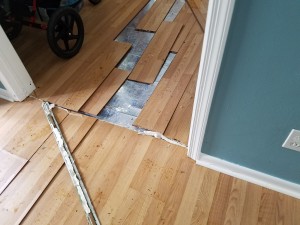Anyone who has done major home renovations recently is likely aware of the concept of “floating floors.” DIY-ers can quickly and easily transform a space by clicking together planks of laminate, vinyl or wood over their existing floors and revel in the beauty they’ve created. These floors are great, theoretically, and overall I was pleased with the outcome when I installed them in my own home in 2012. There is, however, a very significant downside to floating floors: they literally float. So when Hurricane Matthew floods the interior of your house with a foot of water and you’re trying to gather essentials in order to evacuate your neighborhood, you have to dodge planks of laminate as they float merrily past you down the hallway.
I live in the Windsor Woods area of Virginia Beach. My neighbors and I earned the depressing distinction of being the worst hit street in the state of Virginia and it’s still evident weeks after the floodwaters receded. Personal belongings are stored in metal cargo containers in people’s yards as they remove and replace large chunks of their homes. Most of the “trash” has been hauled away, but large “No Scavenging” and “Residents Only” signs still welcome folks to our street. We share construction tips and power tools and sympathetic ears and wonder whether we’re better off rebuilding our homes on stilts. Will another flood wash away all of our hard work?
It’s tempting to want to take out our anger over our recent misfortune on inaccurate weathermen or unprepared municipalities, but the reality is that our world is changing. Sea levels have risen 14 inches since 1930- placing more and more developed areas at risk for recurrent flooding. The sinking of our area’s land is exacerbated by the overuse of the Potomac Aquifer, which is experiencing such significant pressure decreases that it is shrinking and compacting beneath us. These trends show no sign of abating and thus, as we put our homes back together we must ask ourselves, “What can we do?”
Support Infrastructure Investment
The infrastructure beneath our feet is the unsung hero of our region’s resiliency. Support your city or county’s investment in infrastructure maintenance and improvement. And, be a storm drain steward yourself! It might be easy to rake grass clippings and leaves into storm drains, but these debris cause clogs and cleaning up after those is NOT easy.
Reduce Impervious Surfaces and Install Rain Barrels
Increased development and urban sprawl are contributing to the hardening of our shorelines. Do your part to reverse this trend by planting shrubs and tall grasses on your property and opting for gravel or pervious pavement when constructing driveways and walkways. The more hard surfaces you have on your property, the less rainwater can be soaked-up during a storm, and the more water that will flood our streets. Installing rain barrels at your downspouts is also a great way to prevent extra water from flowing toward storm drains during rain events (and is a great source of water for your plants during dry periods).
Support the Region’s Sustainability Research Initiatives
Hampton Roads is the second largest population at risk of the effects of sea level rise and scientists and engineers in our region are tackling the problem head on. For example, the newly formed Commonwealth Center for Recurrent Flooding Resiliency is facilitating research and education about sea level rise and developing adaptive planning for coastal communities. HRSD’s Sustainable Water Initiative for Tomorrow (SWIFT) is addressing land subsidence by proposing to replenish the Potomac Aquifer with up to 120 million gallons of purified water a day, which hydraulic modeling suggests may reduce the effects of sea level rise by up to 25 percent.
Watching your floors float away and your neighborhood struggle to rebuild after a natural disaster is disheartening. There are very few bright sides to the damage caused by Hurricane Matthew; hopefully, acknowledgement of our region’s vulnerabilities and a push toward positive change will be one of them.
Guest blog contributed by Molly Bertsch, Community Educator with HRSD.


